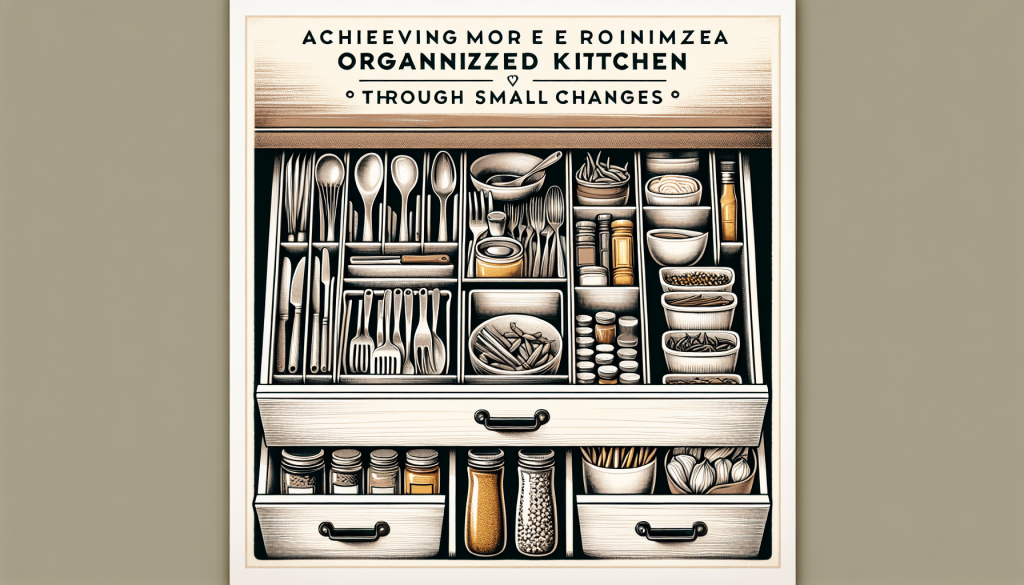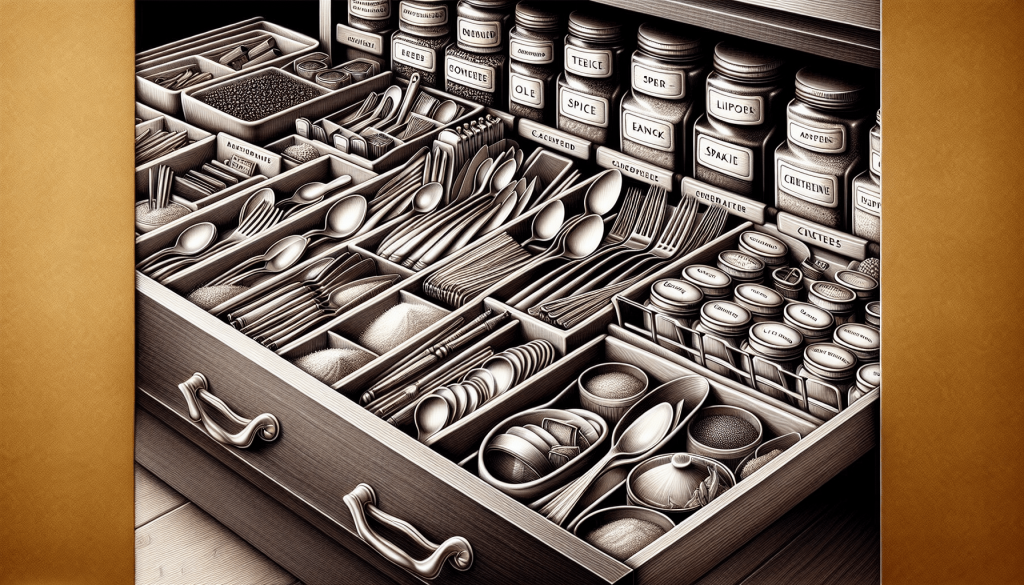If you’ve ever found yourself struggling with a cluttered and chaotic kitchen, fret not! This article is here to guide you on making small changes that can have a big impact on your kitchen organization. From simple storage solutions to clever decluttering techniques, you’ll discover tips and tricks that will transform your kitchen into a well-organized and efficient space. Get ready to say goodbye to tangled utensils and overcrowded cupboards, and hello to a streamlined kitchen that will make cooking a breeze.
Decluttering
Decluttering your kitchen is the first step towards achieving a well-organized space. Start by getting rid of excess items that you no longer use or need. Clear out your pantry and cabinets, and donate or dispose of any expired or unused food items. Be ruthless in your decluttering process and remember that less is more when it comes to creating a streamlined kitchen.
Once you have decluttered your kitchen, the next step is to sort your items by category. Group similar items together, such as baking supplies, cookware, and utensils. This will make it easier to find what you need when you’re cooking or baking. Consider using clear containers or bins to keep smaller items organized and visible.
To further enhance the organization in your kitchen, create designated storage areas for different categories of items. This can include setting up a baking station with all your baking tools and ingredients in one area, or designating a specific cabinet for your spices and pantry staples. By creating designated storage areas, you’ll be able to easily locate and access the items you need when you’re in the middle of preparing a meal.
Optimizing Cabinet Space
Cabinet space is often limited in kitchens, but there are several ways you can optimize it to maximize storage. One effective method is to utilize vertical space with stacking shelves. These shelves allow you to add additional layers to your cabinet, making it easier to store and access items. By stacking items vertically, you can help make the most of the available space and avoid cluttered and disorganized cabinets.
Another way to optimize cabinet space is by installing door organizers. These organizers can be attached to the inside of cabinet doors and provide additional storage for items such as spices, cleaning supplies, or even cutting boards. This not only frees up space inside the cabinet but also keeps frequently used items within easy reach.
Consider adding hooks or tension rods inside your cabinets as well. Hooks can be used to hang mugs, measuring cups, or utensils, while tension rods can be installed to create extra shelf space for items like baking sheets or cutting boards. These simple additions can make a significant difference in utilizing the available cabinet space efficiently.

Drawer Organization
Drawers in the kitchen often become a jumbled mess of utensils, gadgets, and other miscellaneous items. To bring order to your drawers, start by using dividers or trays to separate items into designated compartments. This will prevent items from getting mixed up and make it easier to find what you need.
Take the time to fold utensils in a compact and organized manner. Avoid tossing them into a drawer haphazardly. Instead, place them neatly in divided sections or use drawer organizers specifically designed for cutlery. This approach ensures that your utensils are easily accessible and prevents them from becoming tangled or damaged.
Consider labelling your drawers to make it even easier to find what you’re looking for. Use categories such as “utensils,” “measuring tools,” or “gadgets” to help you quickly identify the contents of each drawer. This simple step can save you time and frustration when you need a specific item while cooking.
Pantry Organization
A well-organized pantry can make meal preparation much more efficient. Start by grouping similar items together. This means putting all your canned goods in one area, placing pasta and grains together, and keeping snacks in a designated section. By grouping items, you’ll eliminate the need to search through the entire pantry to find what you’re looking for.
Consider utilizing clear containers or bins for storage. These containers will allow you to see the contents at a glance, making it easy to identify what you need without rummaging through a cluttered pantry. Use labels on the containers to indicate the contents, ensuring that everything has its designated place.
Create zones in your pantry to further enhance organization. This means assigning specific areas for different food categories. For example, designate a zone for breakfast items, another for baking supplies, and one for snacks. By organizing your pantry into distinct zones, you’ll be able to quickly navigate through and locate the items you need.

Utilizing Wall Space
Don’t overlook the potential of your kitchen walls for extra storage. Installing a pegboard is a fantastic way to hang and display your kitchen tools. By utilizing hooks or pegs, you can easily hang utensils, pots, and pans, freeing up valuable cabinet space and adding a decorative touch to your kitchen.
Magnetic strips are another handy solution for utilizing wall space. Attach a magnetic strip to the wall and use it to hold knives, metal utensils, or even spice containers. This not only clears up drawer space but also keeps your frequently used items within arm’s reach while cooking.
Consider mounting shelves on your kitchen walls for additional storage. These shelves can be used to store cookbooks, decorative items, or even everyday dishes and glassware. By using your wall space effectively, you can create a functional and visually appealing storage solution in your kitchen.
Maximizing Countertop Space
In a busy kitchen, countertop space is at a premium. To make the most of the available surface area, start by identifying essential items that you use regularly and keep them accessible. This could include frequently used appliances, cutting boards, or a utensil crock for your go-to cooking tools. By keeping these items within reach, you can streamline your cooking process and save valuable time.
Consider using stackable storage containers to efficiently use countertop space. These containers can be used to store items like fruits, vegetables, or spices, while allowing you to maximize the vertical space on your countertop. Look for containers that are both functional and aesthetically pleasing to enhance the overall look and organization of your kitchen.
Investing in a wall-mounted spice rack is another great way to optimize countertop space. Spice racks come in various styles, from mounted shelves to magnetic options, offering different storage capacities to suit your needs. This not only frees up valuable counter space but also keeps your spices organized and within easy reach while cooking.
Refrigerator and Freezer Organization
A well-organized refrigerator and freezer can help prevent food waste and make meal planning more manageable. Start by arranging items by category and grouping similar items together. Place all your dairy products in one area, fruits and vegetables in another, and leftovers in a designated section. This approach not only helps you locate what you need quickly but also prevents items from getting lost or forgotten.
Consider using clear bins or containers to further group similar items in your refrigerator and freezer. These containers can be used to store things like condiments, beverage cans, or even pre-prepared meals. By containing items in bins, you can keep your fridge neat and organized, making it easy to see and access everything inside.
Regularly declutter and remove expired products from your refrigerator and freezer. Take a few minutes each week to check the expiration dates and discard any items that are no longer safe to consume. This practice will help keep your fridge organized and ensure that you’re only keeping fresh and usable items on hand.
Labeling and Categorizing
Labeling is a simple yet effective way to maintain an organized kitchen. Start by labelling storage containers and jars. This will help you easily identify the contents and prevent confusion when reaching for ingredients while cooking or baking. Use a label maker or simply a marker and tape to create clear and legible labels.
Categorizing items in your pantry and refrigerator can also contribute to a well-organized kitchen. Use clear labels or stickers to indicate different food categories, such as grains, snacks, or condiments. This approach makes it easy for everyone in the household to find what they’re looking for and ensures that items are returned to their designated spots.
Consider using a labeling system for your spices and pantry staples. Use small adhesive labels or reusable spice jar labels to indicate the name of each spice or staple. This eliminates the need to open multiple containers to find the one you need and helps maintain an orderly and visually appealing spice rack or pantry.
Utilizing the Undersink Area
The undersink area often becomes a cluttered space filled with cleaning supplies and miscellaneous items. To make the most of this area, consider installing shelves or baskets for organization. These additions can create additional storage levels, allowing you to neatly arrange cleaning products or store items like dishcloths and scrub brushes.
Utilize stackable bins or containers for undersink storage. These bins can help keep similar items together and prevent them from rolling around and creating a disorganized mess. Use clear bins or label them to easily identify the contents and save time when you’re looking for a specific item.
Consider designating a specific area under the sink for cleaning supplies. Use a caddy or a hanging organizer to neatly store spray bottles, sponges, and other cleaning tools. By creating a dedicated space for these items, you can easily access them when needed and prevent them from cluttering up the rest of the undersink area.
Creating a Meal Planning Station
Meal planning is a great way to stay organized in the kitchen and save time and money. Designate an area in your kitchen specifically for meal planning. This can be a bulletin board, a calendar, or even a whiteboard. Use this space to write down your weekly meal plan, including the main dishes, side dishes, and any special dietary considerations.
A calendar or whiteboard can be particularly useful for scheduling meals and coordinating grocery shopping trips. Write down the days of the week and plan out your meals accordingly. This will help you stay on track and ensure that you have all the necessary ingredients on hand for each meal.
To keep your recipes and grocery lists organized, invest in a recipe binder or folder. This will allow you to store all your favorite recipes in one place and easily refer to them when planning meals. Use dividers or tabs to categorize recipes by type, such as main dishes, desserts, or vegetarian options. Keep a notepad or sticky notes nearby to jot down items you need to purchase for your meal plan.
By implementing these small changes and incorporating organization strategies into your kitchen routine, you can transform your space into a well-organized and efficient cooking haven. Whether it’s decluttering, utilizing storage solutions, or creating designated areas, the impact of these changes will be significant and make your time in the kitchen more enjoyable and stress-free. So roll up your sleeves, get organized, and prepare to reap the benefits of a neatly organized kitchen!
